Create a new project
Launch IntelliJ IDEA.
If the Welcome screen opens, click New Project.
Otherwise, from the main menu, select .
From the list on the left, select the framework that you want to use in your application.
If suggested, configure the project SDK. To develop Java-based applications, you need a JDK (Java Development Kit).
If the necessary JDK is already defined in IntelliJ IDEA, select it from the Project SDK list.
If the JDK is installed on your computer, but not defined in the IDE, select Add JDK and specify the path to the JDK home directory (for example, /Library/Java/JavaVirtualMachines/jdk-12.0.1.jdk).

If you don't have the necessary JDK on your computer, select Download JDK. In the next dialog, specify the JDK vendor, version, and change the installation path if required.

Other options differ depending on the framework that you have selected. Refer to the list below for the detailed description of options for each framework.
Java
Additional Libraries and Frameworks | Select the technologies, frameworks and languages that you want your project to support, and specify the associated settings. |
Create project from template | Create a simple Java application that includes a class with |
Project name | Specify the project name. |
Project location | Specify the path to the directory in which you want to create the project. By default, the IDE creates a directory with the same name as the project. |
Module name | Specify the module name. By default, the project name is used. For more information on modules and the difference between projects and modules, refer to Configure projects and Modules. |
Content root | Specify the path to the module content root folder (the folder that stores your source code). It's recommended that you use the default path. |
Module file location | Specify the path to the folder where the .iml module file should be created. By default, this file is created in the module content root folder (recommended). |
Project format | It's recommended that you use the directory-based format. |
Maven
Create from archetype | Select this checkbox if you want to use a predefined project template for your project. You can configure your own archetype by clicking Add Archetype. |
Name | Specify the project name. |
Location | Specify the path to the directory in which you want to create the project. By default, the IDE creates a directory with the same name as the project. |
GroupId | Specify a package of a new project. |
ArtifactId | Specify the name of your project. |
Version | Specify a version of a new project. By default, this field is specified automatically. |
Maven home directory | Select a bundled Maven version that is available or the result of resolved system variables such as |
User settings file | Specify the file that contains user-specific configuration for Maven in the text field. If you need to specify another file, select the Override checkbox, click |
Local repository | By default, this field shows the path to the local directory under the user home that stores downloads and contains the temporary build artifacts that you have not yet released. If you need to specify another directory, select the Override checkbox, click |
Properties | By default, the columns in this area display system properties that are passed to Maven for creating a project from the archetype. You can add, remove, and edit these properties. |
Gradle
Kotlin DSL build script | Select this checkbox if you want to use the script. |
Additional Libraries and Frameworks | Select the technologies, frameworks and languages that you want your project to support, and specify the associated settings. |
Name | Specify the project name. |
Location | Specify the path to the directory in which you want to create the project. By default, the IDE creates a directory with the same name as the project. |
GroupId | Specify |
ArtifactId | Specify |
Version | Specify |
Android
Select the type of project you want to create from categories of device form factors that are shown as tabs at the top of the wizard.
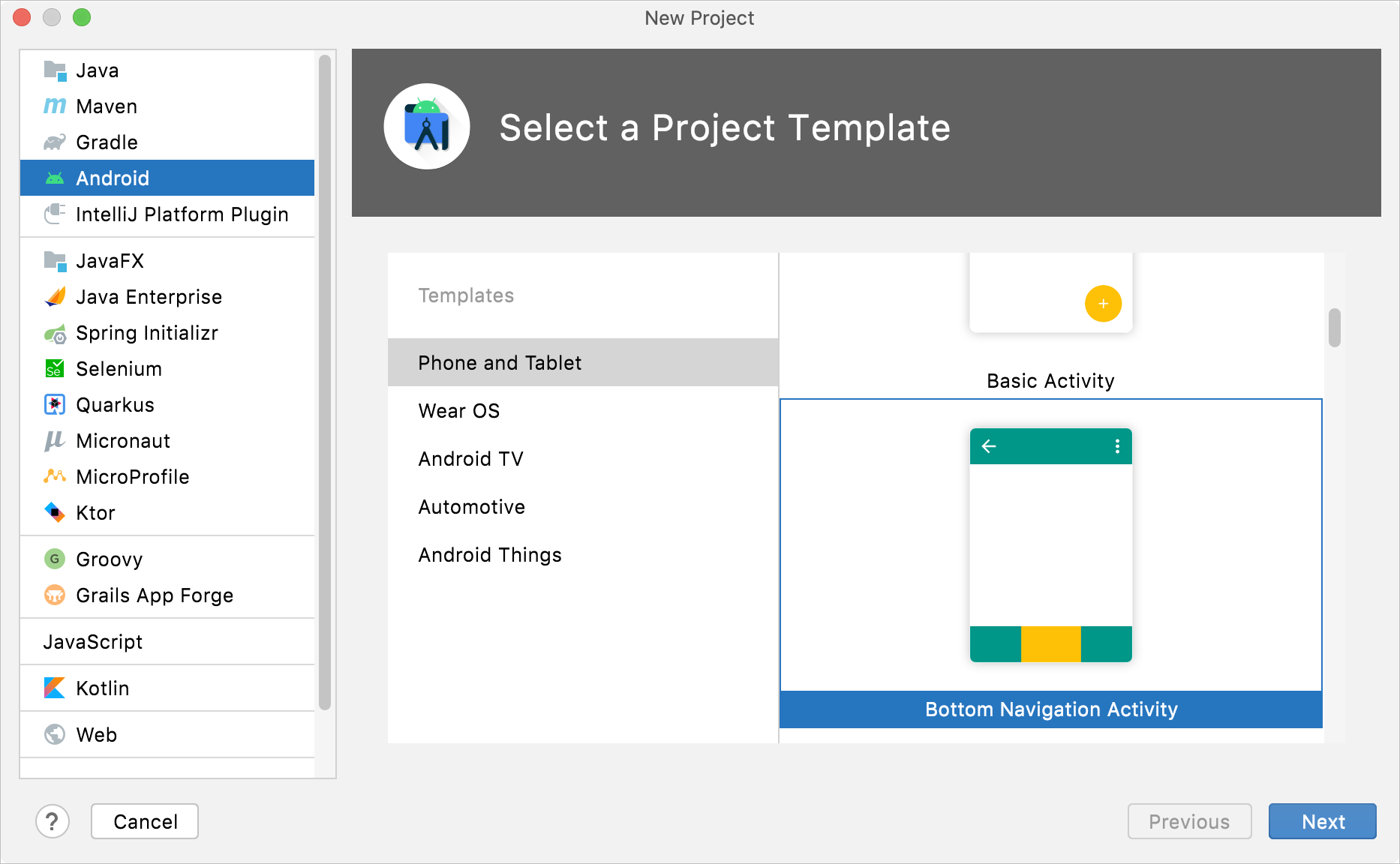
Name | Specify the name for your project. |
Package name | Specify the package name. By default, this package name also becomes your application ID. If necessary, you will be able to change it later. |
Save location | Use this field to specify the location of your project. |
Language | Select the Language you want to use for creating sample code for your new project. |
Minimum SDK | Select the minimum API level that you want to use in the project. If you are not sure which level to select, click the Help me choose link in the dialog. |
This project will support instant apps | Select the checkbox if your project supports instant experiences though Google Play Instant, and you want to enable it for your application. |
IntelliJ Platform Plugin
Project SDK | Select the SDK that you want to use for developing your plugin. |
Additional Libraries and Frameworks | Select the technologies, frameworks and languages that you want your project to support, and specify the associated settings. |
Project name | Specify the project name. |
Project location | Specify the path to the directory in which you want to create the project. By default, the IDE creates a directory with the same name as the project. |
Module name | Specify the module name. By default, the project name is used. For more information on modules and the difference between projects and modules, refer to Configure projects and Modules. |
Content root | Specify the path to the module content root folder (the folder that stores your source code). It's recommended that you use the default path. |
Module file location | Specify the path to the folder where the .iml module file should be created. By default, this file is created in the module content root folder (recommended). |
Project format | It's recommended that you use the directory-based format. |
JavaFX
Name | Specify a name for your project. |
Location | Specify the path to the directory in which you want to create the project. By default, the IDE creates a directory with the same name as the project. |
Language | Select the language that you want to use in your application. |
Build system | Select the build tool that will be used for managing dependencies, testing, packaging, automating the build process, and so on. |
Test framework | Select a testing framework. |
Group | Specify the unique group identifier for your project. It should preferably start with the reversed domain name you control (for example, |
Artifact | Specify a name for the artifact within the group, usually the project's name. |
Project SDK | Select the JDK that you want to use in your project. If the JDK is installed on your computer, but not defined in the IDE, select Add JDK and specify the path to the JDK home directory. If you don't have the necessary JDK on your computer, select Download JDK. |
Select the libraries that you want to use in your application.
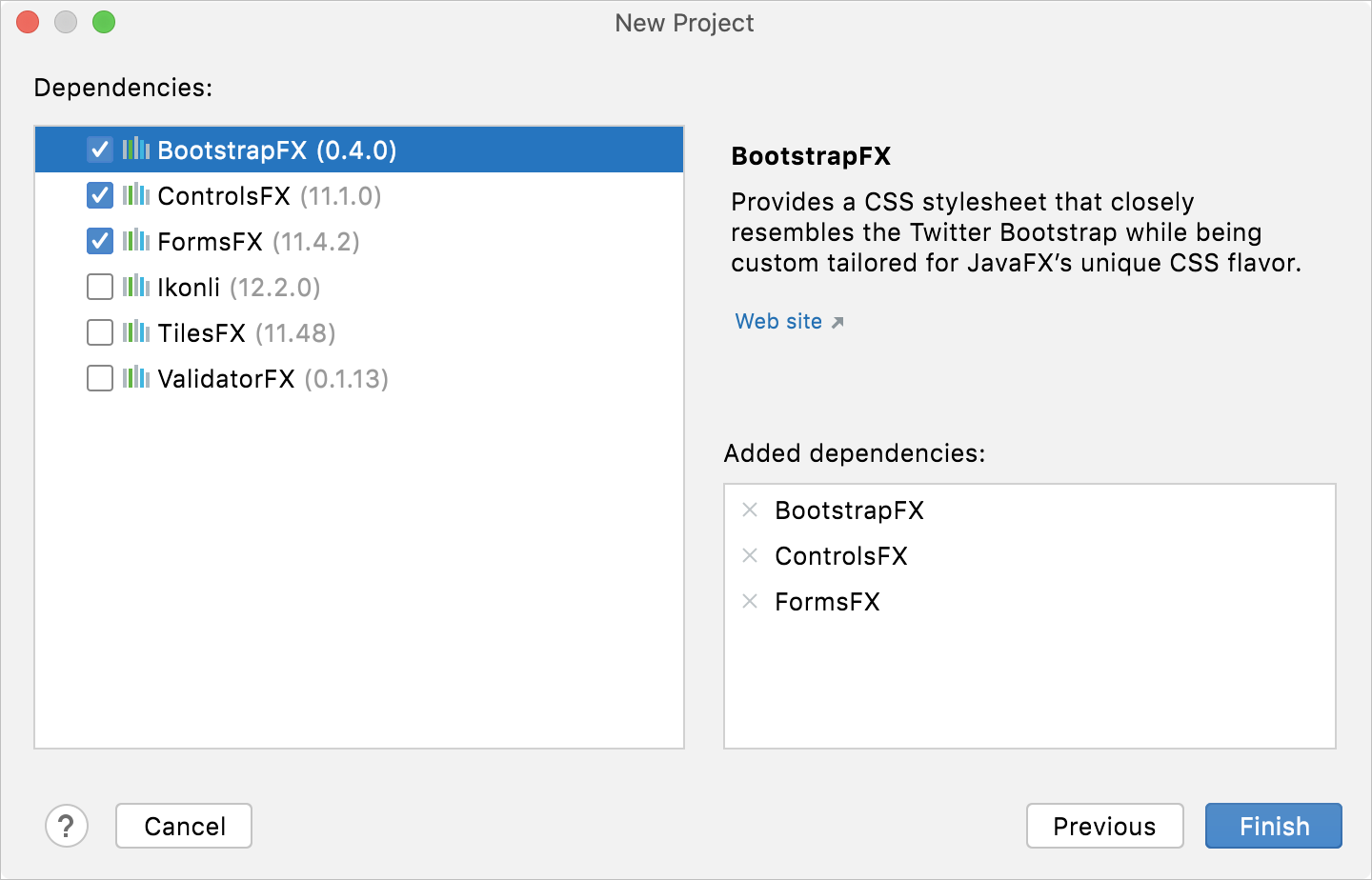
Java Enterprise
Name | Specify a name for your project. |
Location | Specify the path to the directory in which you want to create the project. By default, the IDE creates a directory with the same name as the project. |
Project template | Select a template for your application. IntelliJ IDEA will pre-configure your project accordingly. |
Application server | Specify the application server that you want to use in this application. IntelliJ IDEA provides integration with various application servers, enabling you to start and stop local servers, connect to running remote servers, and deploy your artifacts on those servers. |
Build system | Select the build tool that will be used for managing dependencies, testing, packaging, automating the build process, and so on. |
Test framework | Select a testing framework. |
Language | Select the language that you want to use in your application. |
Group | Specify the unique group identifier for your project. It should preferably start with the reversed domain name you control (for example, |
Artifact | Specify a name for the artifact within the group, usually the project's name. |
Project SDK | Select the JDK that you want to use in your project. If the JDK is installed on your computer, but not defined in the IDE, select Add JDK and specify the path to the JDK home directory. If you don't have the necessary JDK on your computer, select Download JDK. |
Version | Select the Java EE version that you want to use. |
Dependencies | Select the technologies, frameworks and languages that you want your project to support. |
Spring Initializr
Server URL | Use the default https://start.spring.io/ service or specify a custom instance. For more information, see Creating your own instance. |
Name | Specify a name for your project. |
Location | Specify the path to the directory in which you want to create the project. By default, the IDE creates a directory with the same name as the project. |
Language | Select the language that you want to use in your application. |
Type | Select the build tool to use for managing dependencies, testing, packaging, automating the build process, and so on: Maven or Gradle. |
Group | Specify the unique group identifier for your project. It should preferably start with the reversed domain name you control (for example, |
Artifact | Specify a name for the artifact within the group, usually the project's name. |
Package name | Specify the root package of the project. This is usually a combination of the group and artifact names, for example: |
Project SDK | Select the JDK that you want to use in your project. If the JDK is installed on your computer, but not defined in the IDE, select Add JDK and specify the path to the JDK home directory. If you don't have the necessary JDK on your computer, select Download JDK. |
Java | Select the Java version that the initializing service should use. |
Packaging | Select whether you want to package the app as a JAR or WAR. |
Spring Boot | Select the Spring Boot version. |
Download pre-built shared indexes for JDK and Maven libraries | Silently download the pre-built shared indexes for JDK and Maven libraries instead of building the indexes. For more information, see Shared indexes. |
Dependencies | Select starters and dependencies for your project. If you select technologies that require additional plugins, the IDE will notify you about it once the project is created, and will suggest installing or enabling them. |
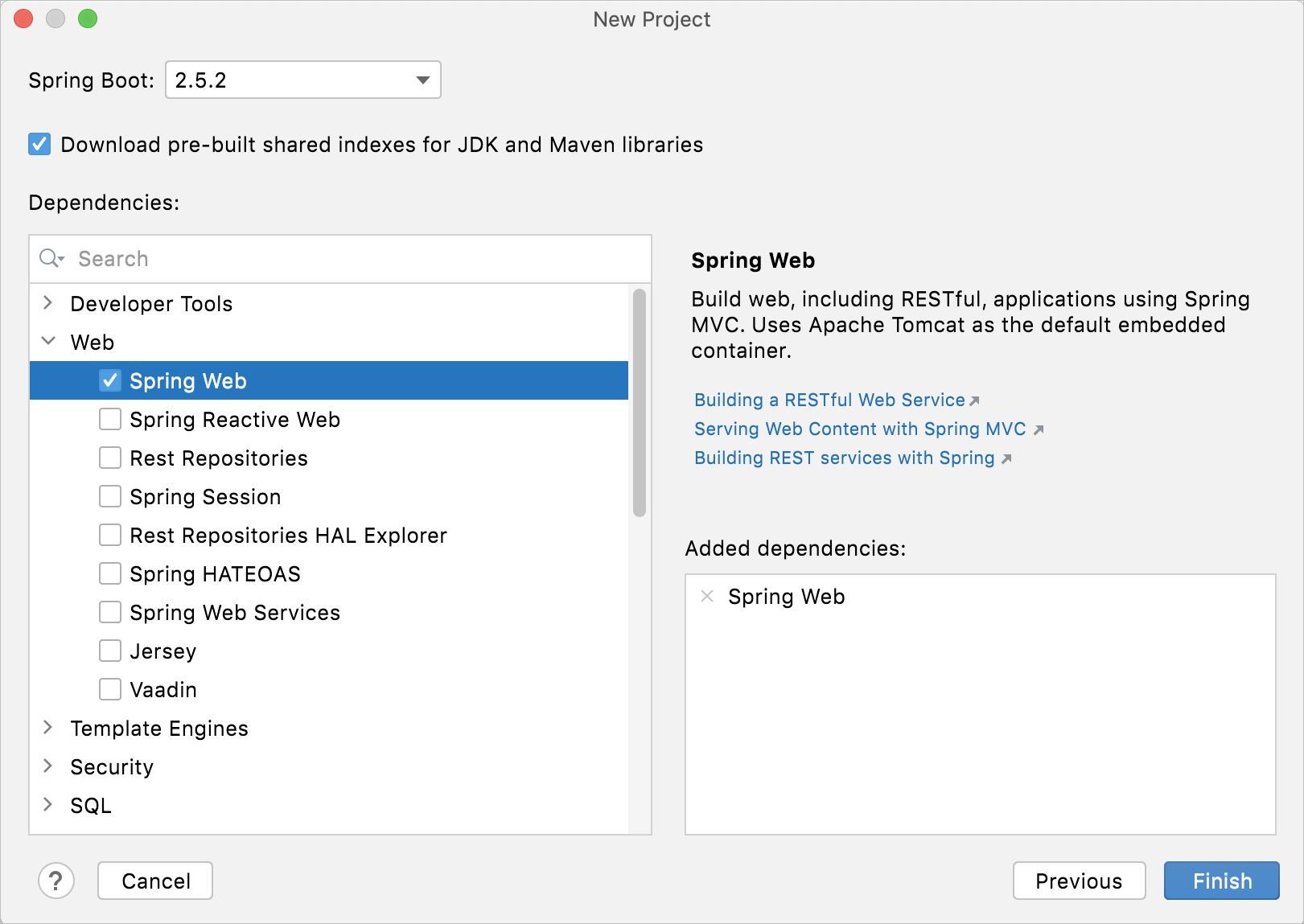
Quarkus
Server URL | Specify the URL of the starter service that you want to use in your application. By default, the https://code.quarkus/io instance is specified, but you can use another custom service. |
Name | Specify a name for your project. |
Location | Specify the path to the directory in which you want to create the project. By default, the IDE creates a directory with the same name as the project. |
Language | Select the language that you want to use in your application. |
Build system | Select the build tool that will be used for managing dependencies, testing, packaging, automating the build process, and so on. |
Group | Specify the unique group identifier for your project. It should preferably start with the reversed domain name you control (for example, |
Artifact | Specify a name for the artifact within the group, usually the project's name. |
Project SDK | Select the JDK that you want to use in your project. If the JDK is installed on your computer, but not defined in the IDE, select Add JDK and specify the path to the JDK home directory. If you don't have the necessary JDK on your computer, select Download JDK. |
Example code | Create a code sample together with the project. |
Select extensions that you want to use in your project. If you select technologies that require additional plugins, the IDE will notify you about it once the project is created, and will suggest installing or enabling them.
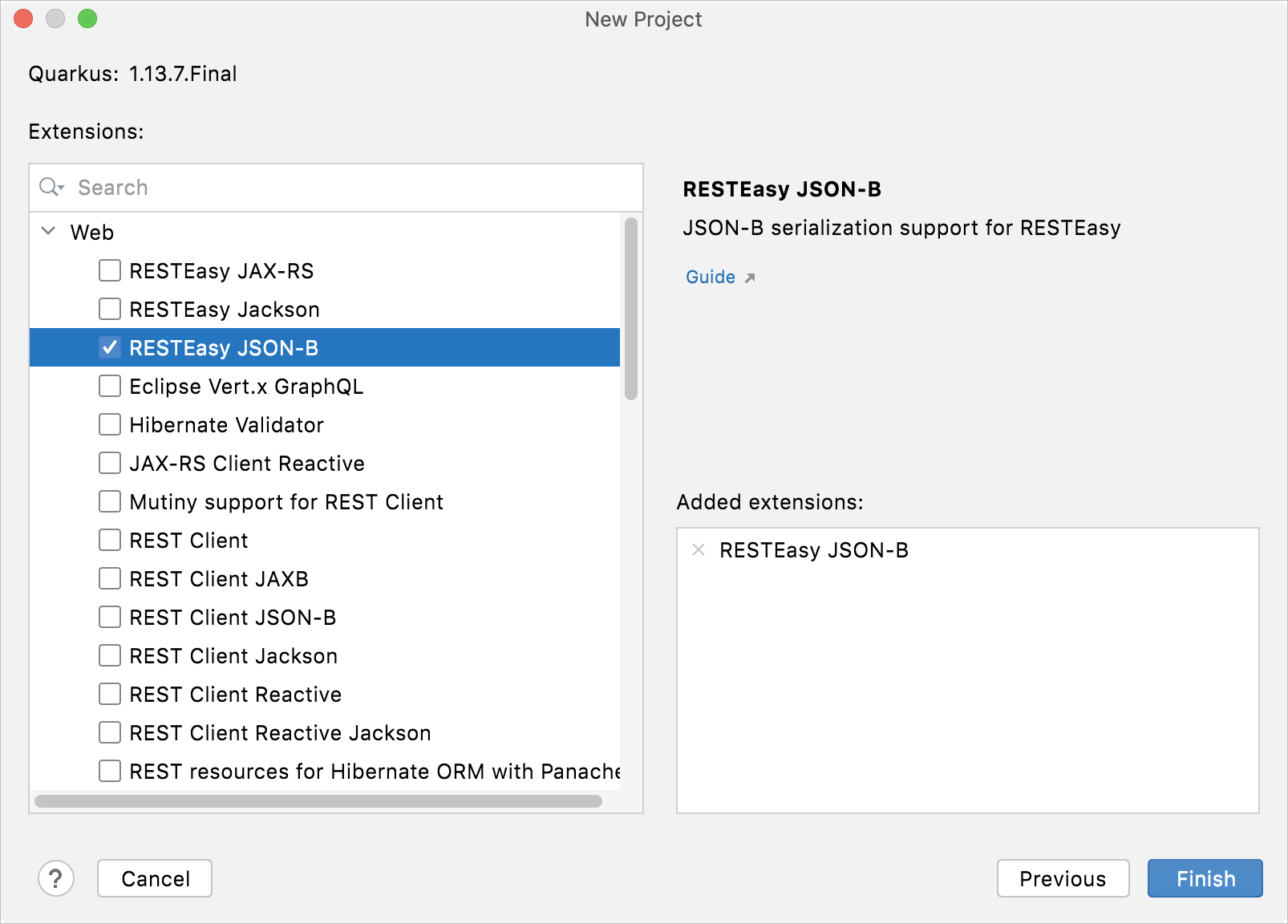
For more information, refer to Quarkus.
Micronaut
Server URL | Specify the URL of the starter service that you want to use in your application. By default, the https://micronaut.io/launch/ instance is specified, but you can use another custom service. |
Name | Specify a name for your project. |
Location | Specify the path to the directory in which you want to create the project. By default, the IDE creates a directory with the same name as the project. |
Language | Select the language that you want to use in your application. |
Build system | Select the build tool that will be used for managing dependencies, testing, packaging, automating the build process, and so on. |
Test framework | Select a testing framework. |
Group | Specify the unique group identifier for your project. It should preferably start with the reversed domain name you control (for example, |
Artifact | Specify a name for the artifact within the group, usually the project's name. |
Application type | Select an application type from thr list. |
Project SDK | Select the JDK that you want to use in your project. If the JDK is installed on your computer, but not defined in the IDE, select Add JDK and specify the path to the JDK home directory. If you don't have the necessary JDK on your computer, select Download JDK. |
Java | Select the Java version that the initializing service should use. |
Select extensions that you want to use in your project. If you select technologies that require additional plugins, the IDE will notify you about it once the project is created, and will suggest installing or enabling them.
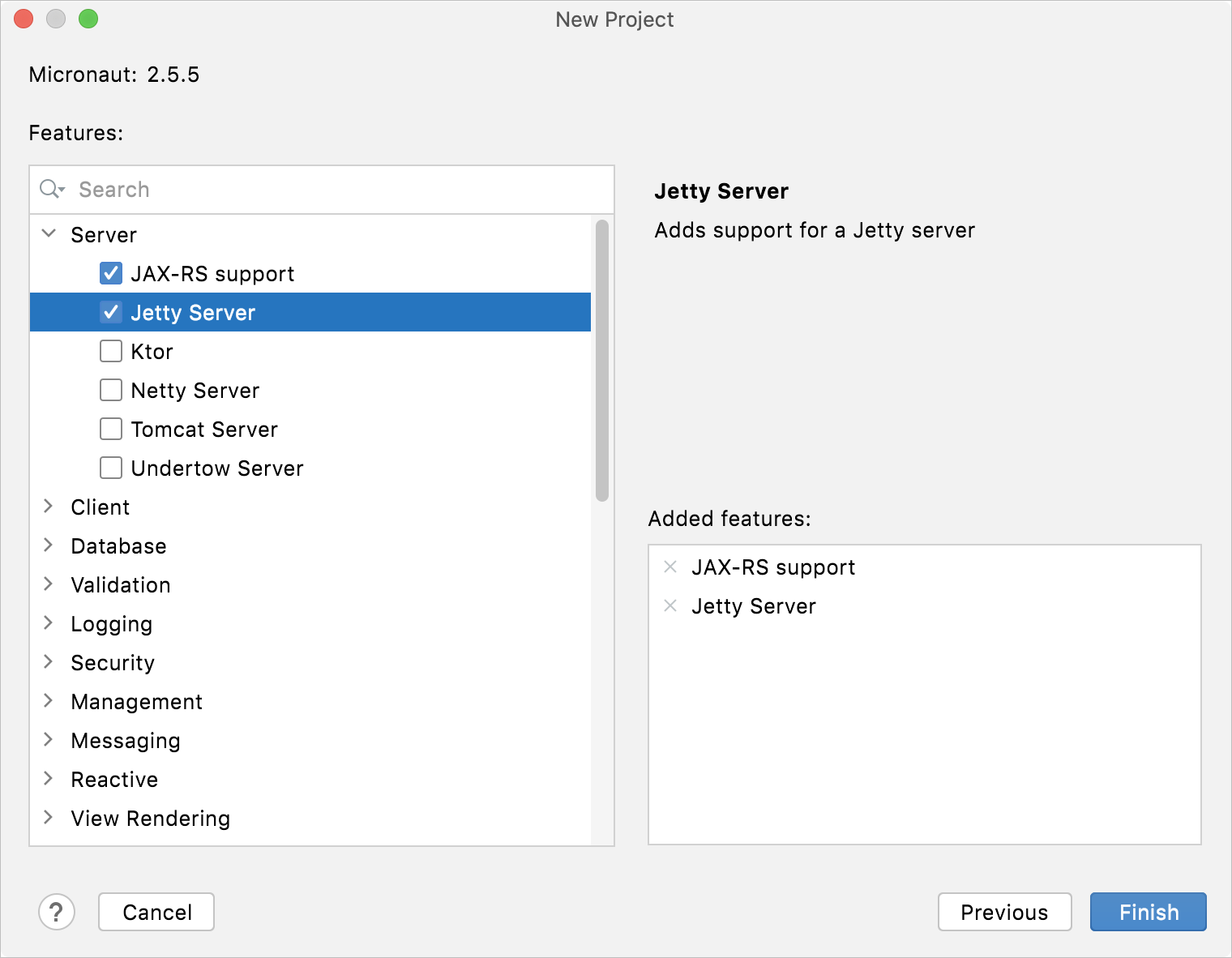
For more information, refer to Micronaut.
MicroProfile
Server URL | Specify the URL of the starter service that you want to use in your application. By default, the https://start.microprofile.io/ instance is specified, but you can use another custom service. |
Name | Specify a name for your project. |
Location | Specify the path to the directory in which you want to create the project. By default, the IDE creates a directory with the same name as the project. |
Runtime | Select the MicroProfile runtime that you want to use. |
Group | Specify the unique group identifier for your project. It should preferably start with the reversed domain name you control (for example, |
Artifact | Specify a name for the artifact within the group, usually the project's name. |
Project SDK | Select the JDK that you want to use in your project. If the JDK is installed on your computer, but not defined in the IDE, select Add JDK and specify the path to the JDK home directory. If you don't have the necessary JDK on your computer, select Download JDK. |
Select specifications that you want to use in your project. If you select technologies that require additional plugins, the IDE will notify you about it once the project is created, and will suggest installing or enabling them.
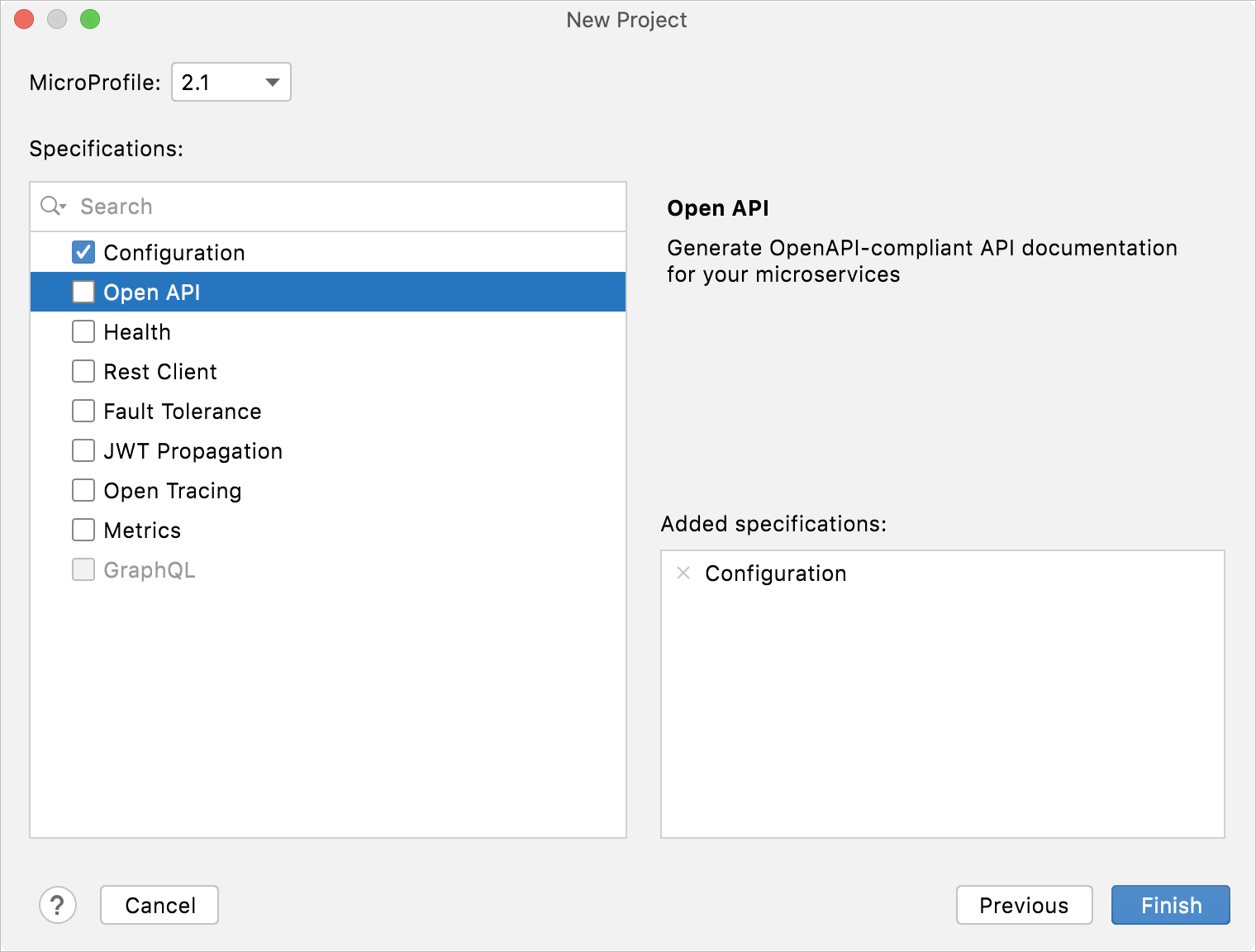
Ktor
Name | Specify a name for your project. |
Location | Specify the path to the directory in which you want to create the project. By default, the IDE creates a directory with the same name as the project. |
Build system | Select the build tool that will be used for managing dependencies, testing, packaging, automating the build process, and so on. |
Website | A domain used to generate a package name. |
Artifact | A generated artifact name. |
Ktor Version | A required Ktor version. |
Engine | An engine used to run a server. |
Configuration in | Select whether to specify server parameters in code or in a HOCON file. |
Add sample code | Leave this option enabled to add sample code for plugins added on the next page. |
On the next page, select plugins (formerly known as features) that you want to use in this application. They provide common functionality of a Ktor application, for example, authentication, serialization and content encoding, compression, cookie support, and so on.
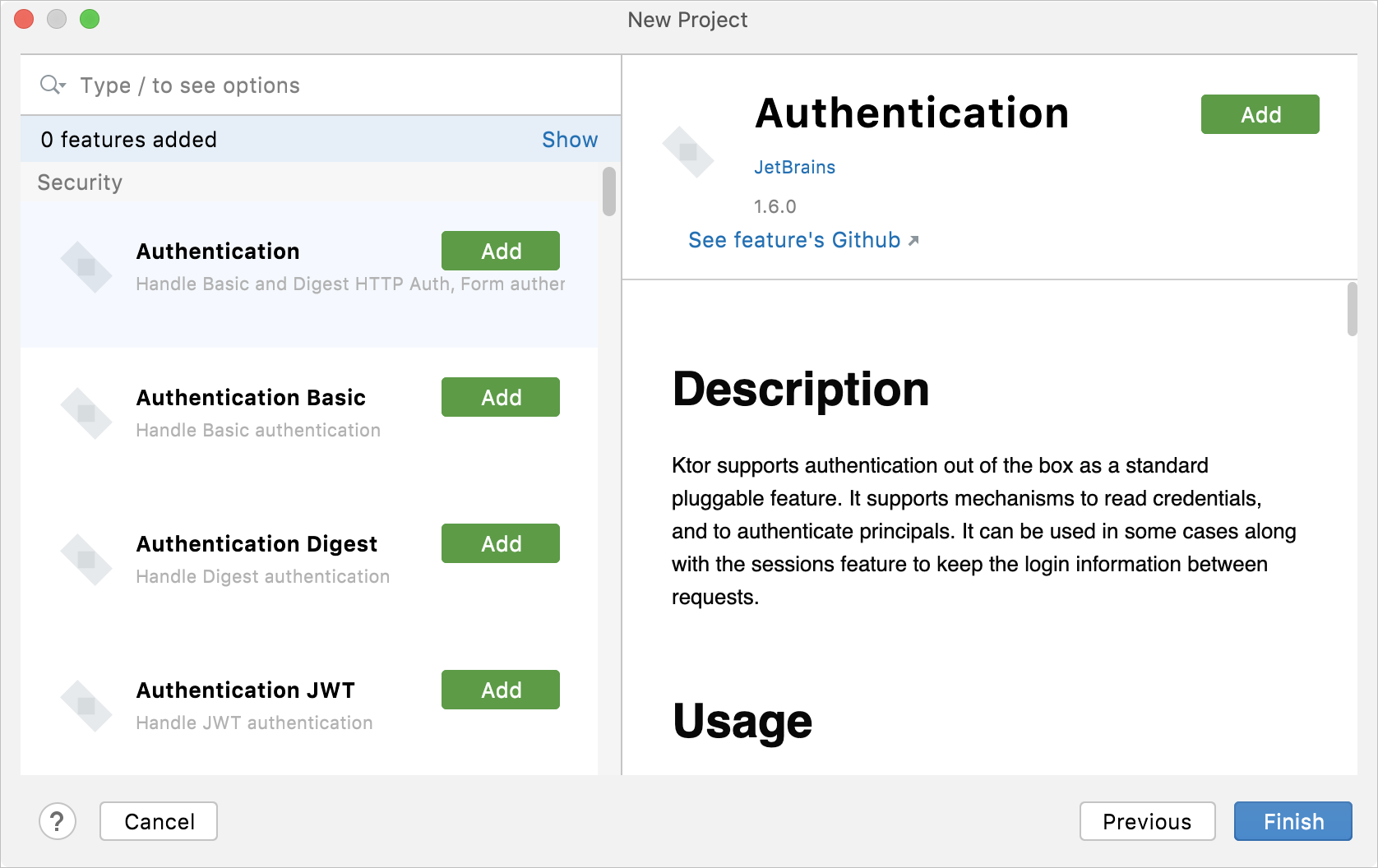
Groovy
Groovy library | If the necessary version of Groovy is already defined in IntelliJ IDEA, select it from the list. Alternatively, click Create and select the Groovy installation directory. |
Additional Libraries and Frameworks | Select the technologies, frameworks and languages that you want your project to support, and specify the associated settings. |
Project name | Specify the project name. |
Project location | Specify the path to the directory in which you want to create the project. By default, the IDE creates a directory with the same name as the project. |
Module name | Specify the module name. By default, the project name is used. For more information on modules and the difference between projects and modules, refer to Configure projects and Modules. |
Content root | Specify the path to the module content root folder (the folder that stores your source code). It's recommended that you use the default path. |
Module file location | Specify the path to the folder where the .iml module file should be created. By default, this file is created in the module content root folder (recommended). |
Project format | It's recommended that you use the directory-based format. |
Grails App Forge
Project SDK | Select the JDK that you want to use in your project. If the JDK is installed on your computer, but not defined in the IDE, select Add JDK and specify the path to the JDK home directory. If you don't have the necessary JDK on your computer, select Download JDK. |
Grails version | Select the Grails version that you want to use in your application. |
Profile | Select the necessary application profile. |
Features | Select the necessary checkboxes to specify features for your project. |
Project name | Specify the project name. |
Project location | Specify the path to the directory in which you want to create the project. By default, the IDE creates a directory with the same name as the project. |
Module name | Specify the module name. By default, the project name is used. For more information on modules and the difference between projects and modules, refer to Configure projects and Modules. |
Content root | Specify the path to the module content root folder (the folder that stores your source code). It's recommended that you use the default path. |
Module file location | Specify the path to the folder where the .iml module file should be created. By default, this file is created in the module content root folder (recommended). |
Project format | It's recommended that you use the directory-based format. |
JavaScript (Static Web)
Select the necessary framework:
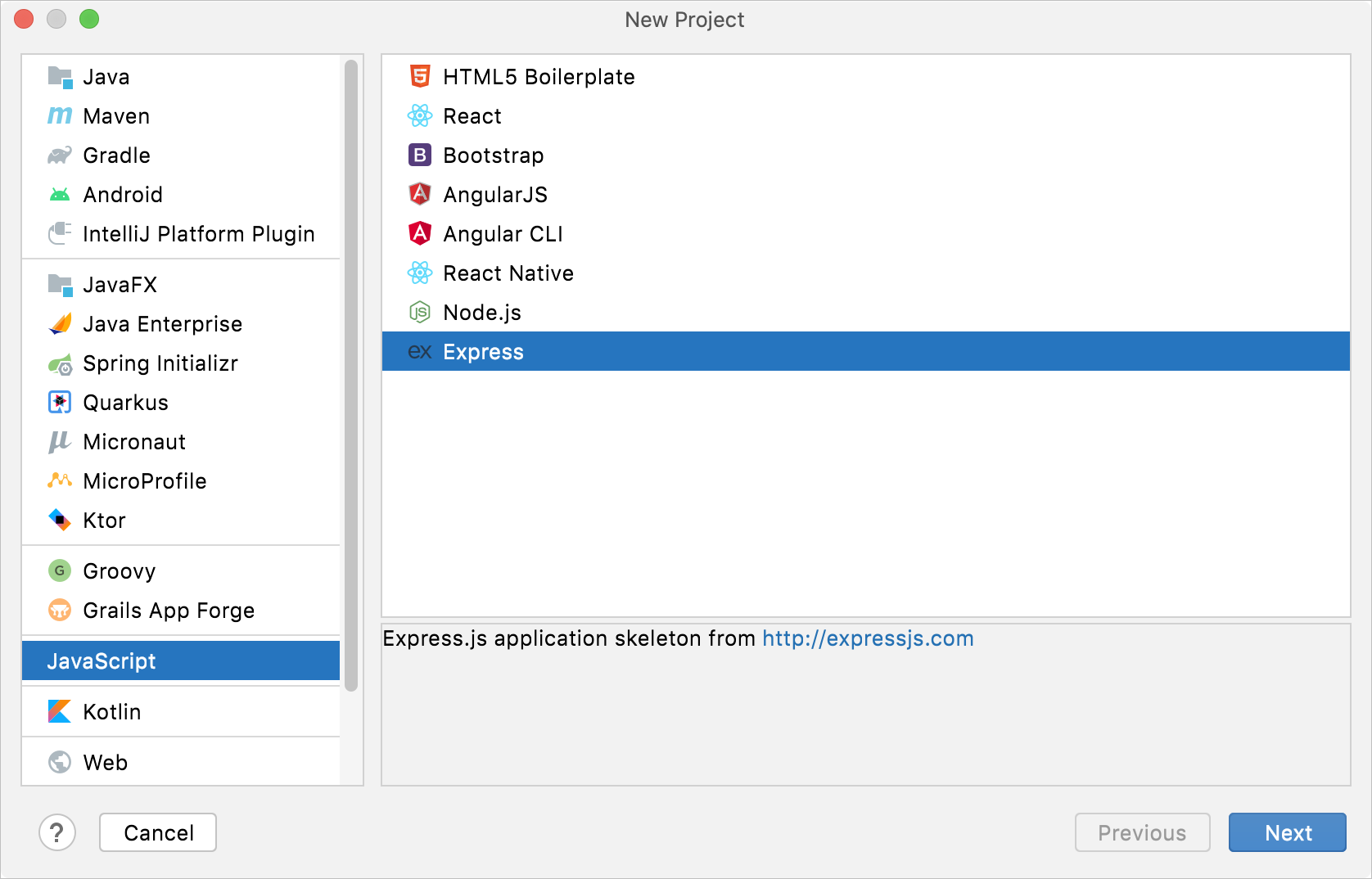
Project name | Specify the project name. |
Project location | Specify the path to the directory in which you want to create the project. By default, the IDE creates a directory with the same name as the project. |
Version | Specify the version of the template in accordance to which the stub will be generated. Click |
Module name | Specify the module name. By default, the project name is used. |
Content root | Specify the path to the module content root folder (the folder that stores your source code). It's recommended that you use the default path. |
Module file location | Specify the path to the folder where the .iml module file should be created. By default, this file is created in the module content root folder (recommended). |
Project format | It's recommended that you use the directory-based format. |
Project name | Specify the project name. |
Project location | Specify the path to the directory in which you want to create the project. By default, the IDE creates a directory with the same name as the project. |
Node interpreter | Specify the Node.js interpreter that you want to use in this project. You can select a configured interpreter from the list or click Add to configure a new one. If you have no Node.js on your computer, select Download Node.js from the list. |
create-react-app | Select npx create-react-app. Alternatively, for npm version 5.1 and earlier, install the |
Create TypeScript project | Select this checkbox to enable TypeScript for your project. |
Module name | Specify the module name. By default, the project name is used. |
Content root | Specify the path to the module content root folder (the folder that stores your source code). It's recommended that you use the default path. |
Module file location | Specify the path to the folder where the .iml module file should be created. By default, this file is created in the module content root folder (recommended). |
Project format | It's recommended that you use the directory-based format. |
Project name | Specify the project name. |
Project location | Specify the path to the directory in which you want to create the project. By default, the IDE creates a directory with the same name as the project. |
Version | Specify the version of the template in accordance to which the stub will be generated. Click |
Module name | Specify the module name. By default, the project name is used. |
Content root | Specify the path to the module content root folder (the folder that stores your source code). It's recommended that you use the default path. |
Module file location | Specify the path to the folder where the .iml module file should be created. By default, this file is created in the module content root folder (recommended). |
Project format | It's recommended that you use the directory-based format. |
Project name | Specify the project name. |
Project location | Specify the path to the directory in which you want to create the project. By default, the IDE creates a directory with the same name as the project. |
Version | Specify the version of the template in accordance to which the stub will be generated. Click |
Module name | Specify the module name. By default, the project name is used. |
Content root | Specify the path to the module content root folder (the folder that stores your source code). It's recommended that you use the default path. |
Module file location | Specify the path to the folder where the .iml module file should be created. By default, this file is created in the module content root folder (recommended). |
Project format | It's recommended that you use the directory-based format. |
Project name | Specify the project name. |
Project location | Specify the path to the directory in which you want to create the project. By default, the IDE creates a directory with the same name as the project. |
Node interpreter | Specify the Node.js interpreter that you want to use in this project. You can select a configured interpreter from the list or click Add to configure a new one. If you have no Node.js on your computer, select Download Node.js from the list. |
Angular CLI | Select Alternatively, for npm version 5.1 and earlier, install the |
Additional parameters | (Optional) Specify the extra ng new options to pass to Angular CLI. Code completion is available in this field: as you start typing the name of an option or press Ctrl+Space, IntelliJ IDEA shows you the available options and their description. |
Module name | Specify the module name. By default, the project name is used. |
Content root | Specify the path to the module content root folder (the folder that stores your source code). It's recommended that you use the default path. |
Module file location | Specify the path to the folder where the .iml module file should be created. By default, this file is created in the module content root folder (recommended). |
Project format | It's recommended that you use the directory-based format. |
Project name | Specify the project name. |
Project location | Specify the path to the directory in which you want to create the project. By default, the IDE creates a directory with the same name as the project. |
Node interpreter | Specify the Node.js interpreter that you want to use in this project. You can select a configured interpreter from the list or click Add to configure a new one. If you have no Node.js on your computer, select Download Node.js from the list. |
React Native | Select Alternatively, for npm version 5.1 and earlier, install the |
Module name | Specify the module name. By default, the project name is used. |
Content root | Specify the path to the module content root folder (the folder that stores your source code). It's recommended that you use the default path. |
Module file location | Specify the path to the folder where the .iml module file should be created. By default, this file is created in the module content root folder (recommended). |
Project format | It's recommended that you use the directory-based format. |
Project name | Specify the project name. |
Project location | Specify the path to the directory in which you want to create the project. By default, the IDE creates a directory with the same name as the project. |
Node interpreter | In this field, specify the Node.js interpreter to use. This can be a local Node.js interpreter or a Node.js on Windows Subsystem for Linux. . |
Package manager | Specify the location of the Node.js package manager file npm.cmd. In most cases, IntelliJ IDEA detects the Node.js executable and fills in the field automatically. |
Module name | Specify the module name. By default, the project name is used. |
Content root | Specify the path to the module content root folder (the folder that stores your source code). It's recommended that you use the default path. |
Module file location | Specify the path to the folder where the .iml module file should be created. By default, this file is created in the module content root folder (recommended). |
Project format | It's recommended that you use the directory-based format. |
Project name | Specify the project name. |
Project location | Specify the path to the directory in which you want to create the project. By default, the IDE creates a directory with the same name as the project. |
Node interpreter | In this field, specify the Node.js interpreter to use. This can be a local Node.js interpreter or a Node.js on Windows Subsystem for Linux. . |
Package manager | Specify the location of the Node.js package manager file npm.cmd. In most cases, IntelliJ IDEA detects the Node.js executable and fills in the field automatically. |
Version | Select the version of the template in accordance to which the stub will be generated. Click |
View Engine | Select the template engine that you want to use. |
Stylesheet Engine | Select the CSS preprocessor for your project. |
Module name | Specify the module name. By default, the project name is used. |
Content root | Specify the path to the module content root folder (the folder that stores your source code). It's recommended that you use the default path. |
Module file location | Specify the path to the folder where the .iml module file should be created. By default, this file is created in the module content root folder (recommended). |
Project format | It's recommended that you use the directory-based format. |
Kotlin
During step 1, global project properties are defined.
Name | The project name. |
Location | The path to the directory where the project will be located. If not specified, IntelliJ IDEA uses the default directory (). |
Project Template | Defines the initial project structure. Depending on the purpose, select one of the following templates: JVM
Multiplatform
Kotlin/JS
Compose Multiplatform
|
Build system | Select the build tool that will be used for managing dependencies, testing, packaging, automating the build process, and so on. |
Project JDK | The JDK that will be used in the project (version 1.8 or later is recommended). The JDK:
If you don't have a JDK installed, you can download it right in the dialog. |
Group ID | The unique identifier of your organization. Not applicable for IntelliJ build system. |
Artifact ID | The unique name of the primary artifact for this project. Not applicable for IntelliJ build system. |
Version | The version of the primary artifact generated by the project. Not applicable for IntelliJ build system. |
Kotlin Runtime | The Kotlin Runtime library that will be used in the project. Only required for IntelliJ build system. |
During step 2, the module structure of the project is configured. This step is optional.
JVM settings
Target JVM version | The version of the JVM bytecode that will be produced as the result of compiling this module. |
Test framework | The framework that will be used for unit testing. |
Multiplatform settings
Use kotlin.test | Adds the kotlin.test library annotations and assert functions for unit testing (enabled by default). |
Kotlin/JS settings
Use kotlin.test | Adds the kotlin.test library annotations and assert functions for unit testing (enabled by default). |
Use new JS IR compiler | Learn more about the features available in the new Kotlin/JS IR compiler (disabled by default). |
Browser-specific settings
Use kotlinx.html
Type-safe Kotlin DSL for creating HTML elements and building DOM trees.
React-specific settings
Use styled-components
Adds a type-safe way to author and inject CSS stylesheets.
Use react-router-dom
Adds navigational components to keep the URLs and UIs synchronized.
Use react-redux
Adds state containers powered by Redux.
Node.js-specific settings
Use experimental Nod.js API (kotlinx-nodejs)
Allows access to Node.js specific features.
Compose Multiplatform settings
Desktop-specific settings
Template
Defines the initial project structure. Select one of the templates depending on your purposes.
Target JVM version
The version of the JVM bytecode that will be produced as the result of compiling this module.
Test framework
The framework that will be used for unit testing.
Multiplatform-specific settings
Name
The name of the module.
Android SDK
Android SDK that will be used for the current module.
Module dependencies
The list of modules the current module depends on.
Web-specfic settings
Template
Defines the initial project structure. Select one of the templates depending on your purposes.
Use kotlin.test
Adds the kotlin.test library annotations and assert functions for unit testing (enabled by default).
Web
Project name | Specify the project name. |
Project location | Specify the path to the directory in which you want to create the project. By default, the IDE creates a directory with the same name as the project. |
Module name | Specify the module name. By default, the project name is used. For more information on modules and the difference between projects and modules, refer to Configure projects and Modules. |
Content root | Specify the path to the module content root folder (the folder that stores your source code). It's recommended that you use the default path. |
Module file location | Specify the path to the folder where the .iml module file should be created. By default, this file is created in the module content root folder (recommended). |
Project format | It's recommended that you use the directory-based format. |
Multi-module Project
Empty projects are created without modules. For such projects, you need to manually create at least one module, add content roots, and configure an SDK.
Select Multi-module Project and click Next.

Project name | Specify the project name. |
Project location | Specify the path to the directory in which you want to create the project. By default, the IDE creates a directory with the same name as the project. |
Project format | It's recommended that you use the directory-based format. |
Empty Project
This project type allows you to work with files of different types and compile individual Java and Kotlin classes. Projects of this type are created without a predefined structure, so you can configure it yourself according to your needs.
Project name | Specify the project name. |
Project location | Specify the path to the directory in which you want to create the project. By default, the IDE creates a directory with the same name as the project. |